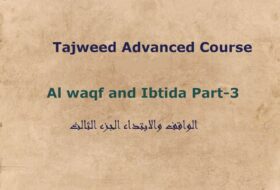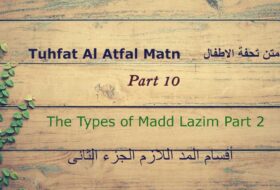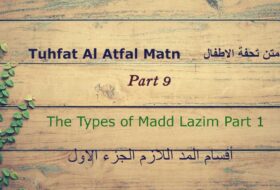Tajweed Course for beginner Part-16
THE MUDOOD (LENGTHENINGS) PART 2 أحكام المدود الجزء الثانى
Madd Causes.
1-Madd Caused by Hamza
2-Madd caused / followed by a sukoon or shaddah.
2-The Exchange Lengthening ( (Madd Al-Badal ) مــــد البـــدل
Madd Al-Badal can simply be defined as (every Hamza preceding a Madd letter).
Madd Al-Badal, if not followed by a Saakin letter or Hamzah, is prolonged only 2 beats.

What is that mean ?
As seen these words originally had two hamzahs, the first one had a vowel and the second a sukoon. The second hamzah was changed into a madd letter from the category of the vowel of the first hamzah (for example if the first hamzah has kasra then the second hamzah changed to yaa).
⇒ Free Helping in Quran And Tajweed ⇐
For More Explanations:
Substitute Lengthening (Madd Badal) ( البدل مد ( occurs when the hamzah precedes a letter of lengthening provided that the letter of lengthening is not followed by a hamzah or a sukoon in the word.
It is so called because the letter of lengthening is mostly a substitute of the hamzah. Originally substitution results from the convergence of two hamzahs in one word, the first is a vowel and the second non-vowelled. So the second hamza is substituted by a letter of lengthening similar in nature to the first vowel by way of lightening. If the first hamzah carries a fataha (a) ( مفتوح آمنوا ,( which was originally ( ءأمنوا .
If the first hamzah carries a kasrah (i) maksur, then the second is substituted by a yaa such as ( إيمان ( which was originally ( إئمان.( If the first hamzah carries a dhammah (u) (madmum) then the second is substituted by a waaw, as ( أوتوا ( which originally was ( أؤتوا .( The rule here is: lengthening to two counts as in the case of normal lengthening.
3-The Substitute Lengthening (Madd ‘Ewadh ) مــــد العوض
Ewadh means: compensation. Madd ‘Ewadh is the replacement of a Tanween Fathah present at the end of a word while sopping at it, with an Alif Madd .
Madd ‘Ewadh is prolonged two beats.
Example:

The lengthening is two counts, which means, the length of two vowels, the same as the counts of natural lengthening. This madd takes place whether there is an alif written after the letter with the tanween or not.
When continuing reading and not stopping on the word that has the tanween with a fat-h, this lengthening disappears, and the noon sakinah rules are applied to the tanween.
If there is an alif written after the tanween, it is dropped when continuing.
Except for Taa Marbuta “ ة .“ The Reader should stop on Taa Marbuta and pronounce it like Haa” هـ “ with Sukoon.
4-The lesser Connecting Lengthening Madd Assilah Assughra مــد الصـلة الصغرى
It is a madd that comes from the vowel on a (pronoun or possessive pronoun haa (ــــه
A haa at the end of a word (last letter) that is not part of the original make up of the word, representing the singular third person male.
It is voweled either with a dhammah or a kasrah, positioned between two voweled letters, the reader is not stopping on it, and it is not followed by a hamzah. When all these requirements are met the dhammah on the haa become lengthened into a lengthened waw or the kasrah on the haa becomes lengthened like a lengthened yaa,
When stopping on this haa we stop with a regular sukoon, and the two count madd is dropped.
















Comments